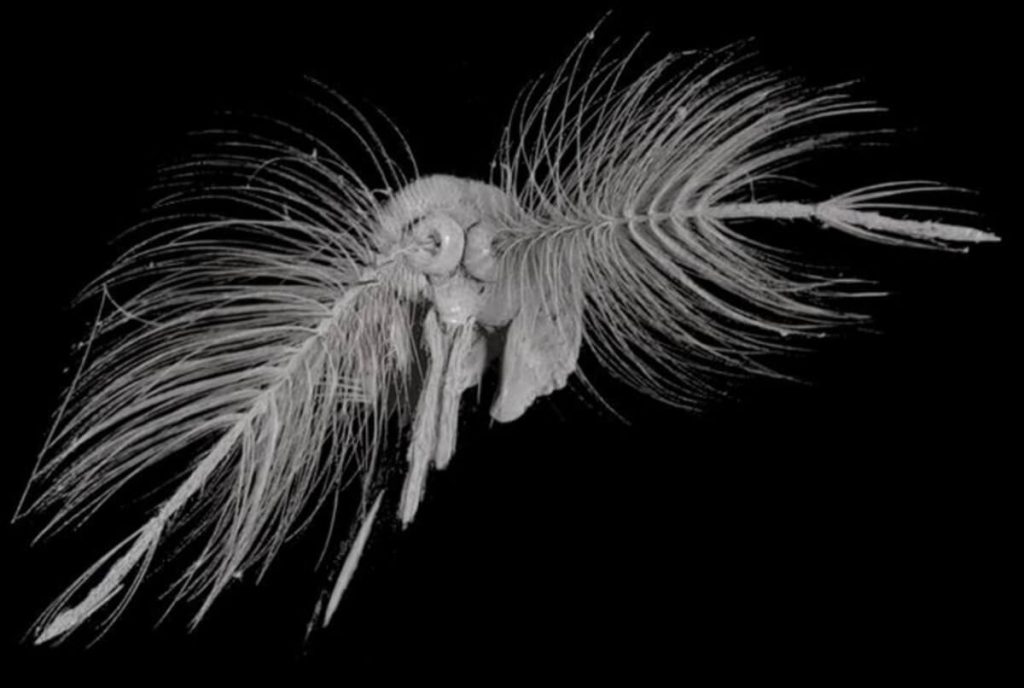

This CT scan is a close-up of the structural features of a male mosquito’s antennae. Purdue University researchers are studying these features to see if they could inform the design of acoustic sensors. (Credit:
Purdue University image/Phani Saketh Dasika)
In a nutshell
- Mosquito antennae are remarkably sophisticated hearing organs that can filter out the noise of their own wingbeats while detecting specific sounds critical for survival, like mate wingbeats or frog calls.
- The sensory hairs on mosquito antennae dramatically increase sensitivity to sound—up to 90 times in male Aedes aegypti—while the tapering shape of antennal segments helps tune which frequencies they respond to best.
- Purdue University researchers are working to recreate these structures through 3D printing, with potential applications in disaster response technology, earthquake detection, and smart noise-canceling materials.
WEST LAFAYETTE, Ind. — Most of us know mosquitoes primarily as unwelcome summer guests, but these tiny insects possess extraordinary sensory abilities that could inspire tomorrow’s technology. A recent study from Purdue University reveals how mosquito antennae function as sophisticated sound detectors that could someday inspire sensors for earthquake detection and disaster response.
Unlike humans who hear through ears, mosquitoes hear through their antennae, those delicate, feather-like structures extending from their heads. What makes this remarkable is how well mosquitoes hear specific sounds despite the constant noise created by their own beating wings. It’s a bit like being able to follow a whispered conversation while using a leaf blower.
The research team, published in Acta Biomaterialia, studied two mosquito species with different hearing needs: Aedes aegypti, which uses sound to find mates, and Uranotaenia lowii, which tracks frog calls to locate its next blood meal.
“By modeling and contrasting the response of the antenna of species of mosquito using sound for different purposes, hearing mates or eavesdropping on frogs, we were able to tease apart features modulating hearing sensitivity and tuning,” says study author Ximena Bernal, a professor of biological sciences at Purdue University, in a statement. “Understanding how these structures work is the first step toward developing acoustic sensors inspired by their sensitive antennae.”
For male Aedes aegypti mosquitoes, finding females is critical for reproduction. They locate potential mates by detecting the distinctive sound of female wing beats amid the buzzing of other males in the swarm. Their antennae have evolved to be extremely sensitive to these specific frequencies.


Purdue University photo/Drew Stone)
Female Uranotaenia lowii mosquitoes, on the other hand, need to track down frogs for blood meals. They’ve developed antennae that can pick up frog mating calls across relatively long distances, even with their own wings beating.
The research team created detailed computer models to understand how these antennae work. They found that mosquito antennae aren’t just passive receivers but sophisticated structures finely tuned to specific frequencies.
“Using advanced micro-CT imaging to create high-fidelity CAD models for finite element analysis, we found that the architectural features of mosquito antennae enable species- and sex-specific acoustic target detection, even amid nontarget signals like their own wingbeats,” says study author Phani Saketh Dasika. “Our findings also suggest that mosquito antennae are capable of detecting a broader range of frequencies than previously thought, though not all of these may be actively utilized.”
A mosquito antenna consists of a central shaft (the flagellum) made up of segments of different sizes stacked together. From these segments extend thin sensory hairs called fibrillae that radiate outward. The interplay between these structures creates such effective hearing.
The team discovered that these sensory hairs dramatically boost sensitivity. For male Aedes aegypti, the presence of hairs increased sound sensitivity by an astounding 90 times compared to a basic rod-shaped antenna. Female Aedes aegypti experienced a seven-fold increase, while male and female Uranotaenia lowii showed 10-fold and nine-fold increases, respectively.


Purdue University photo/Alisha Willett)
This boost comes from the increased surface area that captures sound waves—similar to how a larger solar panel captures more sunlight. But sensitivity alone isn’t enough for effective hearing.
The researchers also found that the tapering shape created by variable segment sizes acts as a natural frequency filter. This helps males focus on female flight tones and helps Uranotaenia lowii females detect frog calls. Each type of mosquito antenna is precisely tuned to frequencies that matter most for their survival and reproduction.
When tested with recordings of actual mosquito wingbeats and frog calls, the results were striking. Male Aedes aegypti antennae could detect female wingbeats even at very low volumes despite the noise from their own wings. Similarly, female Uranotaenia lowii could pick up frog calls through their own wingbeat interference.
This specialization wasn’t universal, though. When exposed to sounds they didn’t evolve to detect (like frog calls for Aedes aegypti females), the antennae only responded well at higher volumes and otherwise mainly detected their own wingbeat frequency. The research team is now working to recreate these antennae through 3D printing, using different materials and sizes to test frequency responses.
“Taking inspiration from nature and using it to advance scientific research has been a core feature of engineering since the very beginning,” says study author Pablo Zavattieri from Purdue’s College of Engineering. “We’re still in the early stages but we’re pretty optimistic that we’ll at least learn a great deal.”
The potential applications go well beyond understanding mosquitoes. The principles behind these antennae could lead to new technologies for acoustic sensing, smarter noise-canceling materials, and specialized sensors for detecting subtle vibrations.
“Imagine urban environments equipped with bio-inspired sensors, akin to ‘big ears,’ capable of discerning specific sounds amid the hustle and bustle of city life,” says Zavattieri. “In times of crisis — such as earthquakes or other disasters — these sensors become invaluable, swiftly detecting faint signals of distress and guiding rescue efforts to those in need.”
For disease-carrying mosquitoes like Aedes aegypti, this research might even lead to better control methods. By understanding how they find mates through sound, scientists might develop ways to disrupt this communication and reduce mosquito populations without relying solely on insecticides.
As for Uranotaenia lowii, their ability to eavesdrop on frog calls shows how evolution can produce highly specialized sensory systems. These mosquitoes have essentially tapped into the frogs’ communication channel for their own benefit, a remarkable adaptation that illustrates the interconnectedness of sensory systems in nature.
That annoying whine of a mosquito flying past your ear represents one of nature’s most sophisticated acoustic systems, a flying marvel of biological engineering perfected over millions of years. While that sound might make you reach for the swatter, its mechanics could inspire new technologies in acoustic sensing, from improved noise cancellation to potentially aiding in disaster response.
Paper Summary
Methodology
The researchers used several techniques to understand how mosquito antennae work. First, they took detailed 3D images of the antennae using microscopy and X-ray scanning, examining multiple specimens of both males and females from each species. To measure how these antennae respond to sound, they used a technique called Laser-Doppler Vibrometry—essentially bouncing laser light off the vibrating antennae to detect tiny movements. They tested responses to sounds at frequencies from 50 to 10,000 Hz (human hearing ranges from about 20 to 20,000 Hz). With this data, they created computer models to simulate how different parts of the antenna contribute to hearing. They built three versions of each antenna type: a simple rod, a rod with varying diameters to mimic the segments, and a complete model with both segments and sensory hairs. This step-by-step approach let them identify exactly which features enhance hearing. Finally, they tested these models with actual recordings of mosquito wingbeats and frog calls to see how the antennae would perform in real-world situations.
Results
The study revealed three major findings about mosquito hearing. First, the sensory hairs dramatically increase how well antennae pick up sound. Male Aedes aegypti mosquitoes, with their distinctly bushy antennae, showed a 90-fold increase in sensitivity compared to a simple antenna without hairs. Females experienced a 7-fold boost, while Uranotaenia lowii males and females showed 10-fold and 9-fold increases. Second, the tapering shape created by varying segment sizes effectively tunes the antenna to focus on specific frequencies. This helps each type of mosquito detect sounds that matter most to them. Third, when tested with biologically relevant sounds, the antennae could pick out their target sounds even with the interference of their own wingbeats. Male Aedes aegypti could detect female wingbeats even at very low volumes, and female Uranotaenia lowii could reliably detect frog calls across various sound levels. In contrast, when tested with irrelevant sounds, the antennae only responded well at high volumes. These results show how each antenna type is precisely adapted to its specific biological function, with structural features that enhance sensitivity to relevant sounds while filtering out background noise.
Limitations
The study has several limitations worth noting. While the computer models were geometrically accurate, they simplified certain aspects of antenna structure. The researchers couldn’t model the exact curvature of sensory hairs due to computational constraints. They also had to estimate material properties for different antenna components since comprehensive data on mosquito antennal tissues isn’t available. Additionally, they simplified the sensory structure at the base of the antenna (called the Johnston’s Organ) to maintain computational efficiency. Another limitation was the focus on mechanical response without fully incorporating how these vibrations get converted to neural signals. The researchers note that non-linearities in this conversion process could influence overall hearing. Finally, the mosquitoes were studied while immobilized, which doesn’t capture the full complexity of hearing during flight when air dynamics change. Despite these limitations, the study provides valuable insights into mosquito hearing mechanics and creates a foundation for future research.
Discussion and Takeaways
This research has implications across multiple fields. From an evolutionary perspective, it shows how mosquitoes developed specialized hearing despite their small size and the challenge of their own wingbeat noise. The differences between male and female Aedes aegypti antennae highlight how sexual selection drives specialized adaptations, while Uranotaenia lowii females demonstrate how sensory systems can evolve for novel purposes like finding hosts. The study reveals sophisticated engineering principles at work in these tiny structures, where small variations in geometry create finely tuned acoustic sensors. The research team is now working to recreate these antennae through 3D printing with different materials and sizes. Potential applications include new acoustic sensors, smart noise-canceling materials for buildings, enhanced hearing aids, and specialized vibration detectors for earthquake monitoring or disaster response. For mosquito control, understanding how disease vectors like Aedes aegypti detect mates could lead to new methods for reducing populations by disrupting their acoustic communication. The study also contributes to our understanding of how sensory systems work in noisy environments—a challenge faced by many organisms, including humans.
Funding and Disclosures
This research received support from the Air Force Office of Scientific Research (AFOSR-FA9550-23-1-0209), the Multi-University Research Initiative (AFOSR-FA9550–15–1–0009), and the National Science Foundation (IOS-2054636). The team used a Zeiss Xradia 510 Versa 3D X-ray Microscope supported by the Purdue EVPRP Major Multi-User Equipment Program 2017. The authors declared no competing financial interests or personal relationships that might have influenced their work.
Publication Information
The study “Mechanistic insights into mosquito antennal architecture for auditory adaptations” was published in Acta Biomaterialia (volume 192, pages 165-174) in 2025. The research team included Adwait A. Trikanad, Phani Saketh Dasika, Hoover Pantoja-Sánchez, Ximena E. Bernal, and Pablo D. Zavattieri from Purdue University and the Smithsonian Tropical Research Institute. The article was received on April 10, 2024, revised on November 27, 2024, accepted on December 11, 2024, and published online on December 16, 2024.








